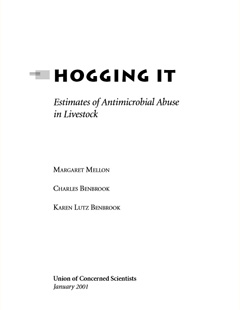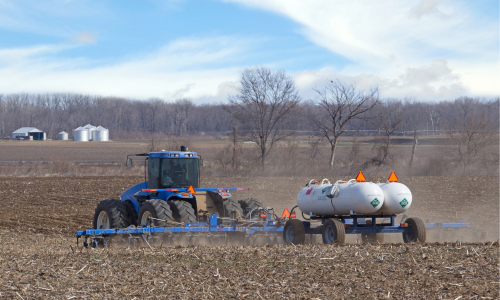Antimicrobial resistance is a public health problem of growing urgency. Although use of antimicrobials in humans is the largest contributor to the problem, use of antimicrobials in agriculture also plays a significant role. Mounting evidence is confirming the view, long held in the public health community, that antimicrobial use in animals can substantially reduce the efficacy of the human antimicrobial arsenal.
Now is the time to act to curb the overuse of antimicrobials in animals. But as public health officials and citizens turn to this task, data on quantities of antimicrobials used are not publicly available, even though these data are critical to designing an effective response to the problem.
This report attempts to fill in that gaping chasm by providing the first transparent estimate of the quantities of antimicrobials used in agriculture. We have devised a methodology for calculating antimicrobial use in agriculture from publicly available information including total herd size, approved drug lists, and dosages. The method is complex but sound, and the results are startling. We estimate that every year livestock producers in the United States use 24.6 million pounds of antimicrobials for nontherapeutic purposes. These estimates are the first available to the public based on a clear methodology. We have been careful in making these estimates, always choosing conservative assumptions. We hope that any critics of this study who claim the estimates are incorrect will provide the documented data needed to refine them.
Conclusions
The results of our study indicate the following:
- Tetracycline, penicillin, erythromycin, and other antimicrobials that are important in human use are used extensively in the absence of disease for nontherapeutic purposes in today's livestock production.
- Cattle, swine, and poultry are routinely given antimicrobials throughout their lives. Many of the antimicrobials given to livestock are important in human medicine.
- The overall quantity of antimicrobials used in agriculture is enormous.
Many consumers will be surprised to find that tens of millions of pounds of antimicrobials are used in livestock systems. We estimate that every year livestock producers in the United States use 24.6 million pounds of antimicrobials in the absence of disease for nontherapeutic purposes: approximately 10.3 million pounds in hogs, 10.5 million pounds in poultry, and 3.7 million pounds in cattle. The tonnage would be even higher if antimicrobials used therapeutically for animals were included.
Previous estimates may be drastic underestimates of total animal use of antimicrobials.
A study recently released by the Animal Health Institute (AHI) may have severely underestimated animal use of antimicrobials. Our estimate of 24.6 million pounds for animal use is almost 50 percent higher than industry's figure of 17.8 million pounds -- and ours includes only nontherapeutic usage in the three major livestock sectors. AHI's covers all uses -- therapeutic and nontherapeutic -- in all animals, not just cattle, swine, and poultry.
Approximately 13.5 million pounds of antimicrobials prohibited in the European Union are used in agriculture for nontherapeutic purposes every year by U.S. livestock producers.
The European Union has prohibited nontherapeutic agricultural use of antimicrobials that are important in human medicine, such as penicillins, tetracyclines, and streptogramins. Total U.S. agricultural use of these banned antimicrobials is enormous.
Driven primarily by increased use in poultry, overall use of antimicrobials for nontherapeutic purposes appears to have risen by about 50 percent since 1985.
According to our estimates, total nontherapeutic antimicrobial use in animals has increased from 16.1 million pounds in the mid-1980s to 24.6 million pounds in 2001.
In poultry, nontherapeutic use since the 1980s has increased by over 8 million pounds (from 2 million to 10.5 million pounds), a dramatic 307 percent increase on a per-bird basis. Growth in the size of the industry accounted for about two-fifths of the overall increase.
In swine, nontherapeutic use has declined slightly (from 10.9 to 10.3 million pounds), although there is growing reliance on tetracycline-based products.
The quantities of antimicrobials used in the absence of disease for nontherapeutic purposes in livestock dwarfs the amount of antimicrobials used in human medicine.
Our estimates of 24.6 million pounds in animal agriculture and 3 million pounds in human medicine suggests that 8 times more antimicrobials are used for nontherapeutic purposes in the three major livestock sectors than in human medicine. By contrast, industry's estimates suggest that two pounds of antimicrobials are used in treating human disease for every pound used in livestock.
Livestock use accounts for the lion's share of the total quantity of antimicrobials used in the United States. Our estimates suggest that nontherapeutic livestock use accounts for 70 percent of total antimicrobial use. When all agricultural uses are considered, the share could be as high as 84 percent. This estimate is far higher than the 40 percent figure commonly given in the literature for the agricultural share of antimicrobial use.
The availability of data on antimicrobial use in fruit and vegetable production demonstrates that credible usage information can be obtained without unduly burdening either agricultural producers or the pharmaceutical industry.
This report presents several years of data on the quantity of antimicrobials used as crop pesticides. These easily accessible data were compiled by the U.S. Department of Agriculture, which uses producer surveys to gather information on pesticide use each year.
Recommendations
- The Food and Drug Administration (FDA) should establish a system to compel companies that sell antimicrobials for use in food animals or that mix them in animal feed or water to provide an annual report on the quantity of antimicrobials sold. The information should be broken out by species and by antimicrobial. It should include the class of antimicrobial, indication, dosage, delivery system, and treatment period.
- The U.S. Department of Agriculture (USDA) should improve the completeness and accuracy of its periodic surveys of antimicrobial use in livestock production.
- The FDA, USDA, and Centers for Disease Control and Prevention (CDC) should speed up implementation of Priority Action 5 of A Public Health Action Plan to Combat Antimicrobial Resistance, the U.S. government's recently published action plan on antimicrobial resistance, which calls for the establishment of a monitoring system and the assessment of ways to collect and protect the confidentiality of usage data.




